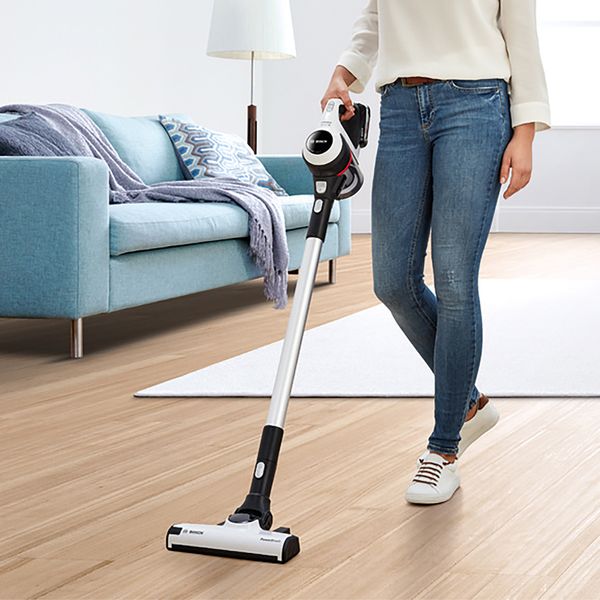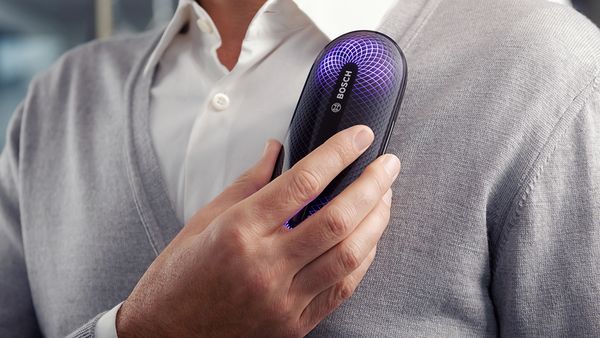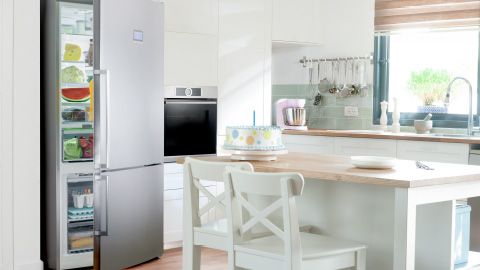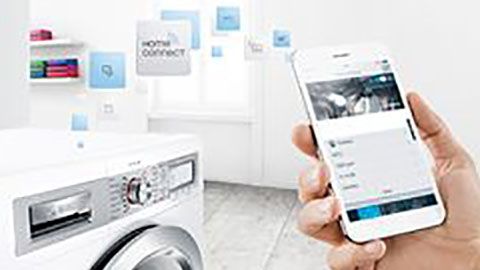House cleaning doesn’t have to feel like a punishment. Admittedly, it is one of those jobs that just has to be done and that few of us enjoy. However, with a few pro tips and an easy-to-follow system, deep cleaning houses could actually become a pleasure. We’re talking about being able to clean your house, two, three, four times as thoroughly in less than half the time, so you can focus on the things that really matter to you.
Want to know more? Read on for our ultimate guide on how to deep clean your house.
Cleaning your house
Let’s talk about why. It may seem obvious, perhaps even self-explanatory, but it’s essential to keep your house clean. No one wants to live in a messy house, but sometimes life can get in the way, and before you know it, you’re knee-deep in a mess. This can be very hard to reverse, but it's necessary.
A dirty, cluttered home can be terrible for your wellbeing. It can cause health conditions like allergies and asthma, increase stress levels and lead to other mental health problems. In summary, keeping your house clean is a good thing. It’s a household job that we all have to do at some point, whether single-handedly or sharing the duties, so it’s essential to know the basics.
How to clean your house
Throughout our lives, we all pick up a bit of house cleaning knowledge here and there, mainly from our parents or other people we’ve lived with. Still, most of us are never really taught how to clean a house. This might explain where lousy cleaning habits and inefficient methods come from and why so many of us make housework much more challenging and more tedious than it needs to be.
Thankfully, if you do want to learn how to do it properly, there’s lots of good practice out there. Here are a few cleaning basics to get you started:
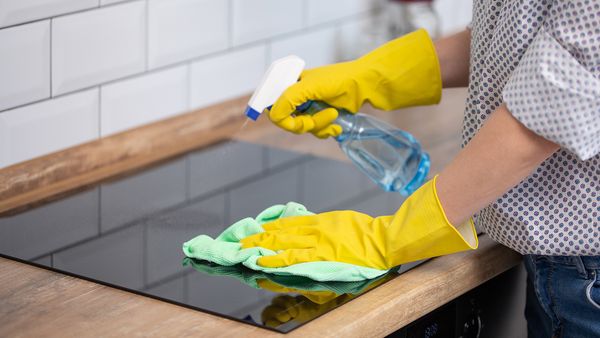

Come up with a simple house cleaning system
Sticking to a simple plan and turning it into a regular routine saves time and improves efficiency. People often ask how to clean a house fast. The answer is that speed comes from repetition and muscle memory. Basically the more you do it, the more time you’ll save off, and the better you’ll get at it.
When it comes to creating a simple plan, this could be cleaning one room at a time, always in the same order, and working your way around each room, starting and finishing in the same spot.
In each room, you could also clean top to bottom, left to right, for instance, to make sure you clean everywhere. There are several methods out there and it almost doesn’t matter which one you choose as long as you have a sensible system and stick to it.
When coming up with your plan, always consider your household’s needs and make sure you include areas that can get forgotten. This might be under heavy furniture, inside the fridge, light fixtures and cabinets.
Create a house cleaning checklist
Once you’ve got a simple plan, keeping a house cleaning checklist is an easy way of helping yourself stay on track. List the rooms and individual cleaning tasks within each room in order, and tick them off as you go.
Set a schedule
Next, decide on a schedule. How often should you clean your house? Weekly cleaning helps keep away dust mites that like to live in fabrics and soft bedding and which can cause allergies and asthma. Regular cleaning also helps maintain the overall cleanliness of your home, reducing the need for a marathon deep clean to get back on top of things.
Declutter before cleaning
Before you spend time cleaning what you might end up throwing out later, start with a declutter first. We’ll have more on decluttering further below, with tips borrowed from famously tidy Marie Kondo. Still, we can’t overstate the importance of starting every clean – from a weekly once-over to a six months’ deep clean – with a declutter.
Clutter gets in your way, increases the volume of items you need to clean (and move), and generally makes your house messier.
What supplies do you need to clean your house?
You can clean a house single-handedly, but not empty-handed. It’s crucial to equip yourself with the necessary supplies before you get started, but the good news is that they don’t have to cost the world.
• Sponge
• Rubber gloves
•Cotton rags
• Paper towels
• Microfiber cloths
• Cleaning fluid for bathrooms, floors and kitchens
• Polish
• Duster
• Mop and bucket
• Broom
While the majority of these supplies are self-explanatory, we wanted to spend a little more time on larger cleaning appliances.
Vacuum cleaner
Choosing the right vacuum cleaner for your home is essential. If you prefer short and frequent cleans, then cordless vacuum cleaners are perfect for you. They’re powerful, light and you can buy innovative models with substantial runtimes.
On the other hand, if you or your family members suffer from allergies, a bagged vacuum cleaner will be more suitable. The sealable dust bag will minimise your exposure to dust particles.
At Bosch, we take cleaning one step above the rest, using superior cleaning technology that removes the large dust balls and other harmful substances that we can’t see. These include allergens, bacteria, mould and toxins. These vacuum cleaners will have a HEPA (or High-Efficiency Particulate Air) filter and potentially a Bionic filter, which provides the added bonus of scented and fresher-smelling air.
Your choice depends on your household needs, so look out for pet-friendly vacuums, silent vacuums and cleaners with nozzles for different types of flooring.
Kitchen appliances
Alongside our indispensable friend, the vacuum cleaner, appliances like your washing machine and dishwasher are also essential for keeping your home and contents clean. If you invest in quality, it will pay you back with premium performance, value for money and reliability.
As a general tip, we also recommend investing in a storage caddy to keep all of your essential supplies such as sponges, rags, cleaning fluids etc. Ideally, it should be lightweight and portable so you can carry it with you from room to room.
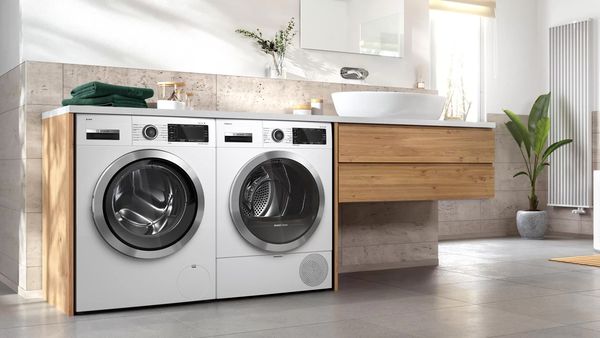
Room-by-room cleaning guide
You’ve got a plan, a checklist and a caddy of cleaning supplies. It’s now time to start cleaning. We’ve put together a guide to deep cleaning houses, starting upstairs with the dreaded bathroom, working our way through the bedrooms, down the stairs, to the kitchen, living room and finally outside. Ready? Take a deep breath and prepare for a deep clean.
Cleaning your bathroom
If cleaning the bathroom is the job you fear the most, it might be worth getting it out of the way first. Here’s our checklist:
1. Clear all the surfaces of products and spray everything, including the toilet bowl, with bathroom cleaning fluid, giving it time to soak.
2.While this is happening, you could be super-efficient by quickly gathering any dirty laundry from the bedrooms or stripping the beds ready for the wash.
3. Back in the bathroom, put on rubber gloves and give the bathtub, shower, tiles and sink a thorough scrub with a brush, then rinse and dry. Give the showerhead attention with cleaning fluid and a brush, to prevent black mould.
4. Next, the toilet bowl; keep your rubber gloves on and use damp paper towels and antibacterial spray to wipe down the outside of the toilet. Then squirt toilet cleaner around the inside of the bowl and under the rim. You can use a toilet brush to give it an extra scrub.
5. After this, clean the bathroom mirror and any other glass with soapy water.
6. Last, the bathroom floor. Make cleaning the bathroom floor with a damp cloth or mop your last job.
Cleaning your bedroom
Next up is your bedrooms. Take one room at a time and only move onto the next one once the last is clean.
1. First, clear away any clutter into wardrobes and drawers – organising those can be a job in themselves.
2. Next, strip the beds and gather up dirty laundry for washing.
3. Re-make the beds with clean sheets.
4. Finally, dust, vacuum and mop (in that order), and don’t forget ceilings and walls.
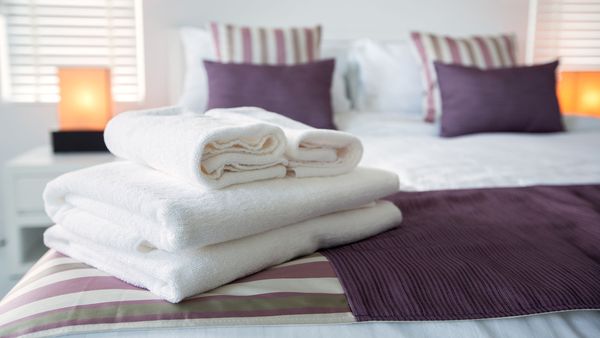

Cleaning your living room
Similar to the bedroom, the main jobs here are dusting and vacuuming. While you don’t have bedding to change, you can wash your curtains and furniture covers. Also, if you have pets, you have to give particular attention to cleaning sofas and chairs.
1. Clear away the clutter.
2. Wipe down the furniture and polish any wood or glass surfaces.
3. Finally, dust, vacuum and mop (in that order) and don’t forget ceilings and walls.
While dusting takes place throughout the whole house, we’re including it in our section on cleaning your living room. Start with your furniture, followed by lighting and lamps, and then finish with small items like picture frames, ornaments and books. It’s worth picking books up and giving each one a wipe all over, as well as the shelf underneath it, rather than just going over them. As a bonus tip, consider a washable microfiber duster with a good reach for those hard to get to corners and light fixtures.
Cleaning your kitchen
Like the bathroom, cleaning the kitchen is one of the bigger, more time-consuming jobs, but it’s so important to do, as this is where you prepare and cook food, dine and socialise.
1. Declutter your surfaces, decant loose items into jars, put dirty dishes into the dishwasher and get rid of expired food.
2. On a related note, make sure your drawers and cupboards are organised – consider utensil holders and shelf dividers. It’s much easier to clean if your cabinets are in order. The same goes for your fridge.
3. Empty your cabinets and drawers and give them a wipe down with a damp cloth. Don’t forget the outside too.
4. Next, clean your fridge. It’s essential to be thorough because food brings with it lots of bacteria. Wash out the drawers and each shelf separately with warm soapy water. You may need to leave them to soak if they are filthy. Make sure they are dry and cool before putting them back into the fridge.
5. Use a sponge, soap and warm water to clean your sink. Make sure the plug hole is thoroughly cleaned, as it can be a real breeding ground for germs.
6. Clean your oven and hob. This can be a big job, depending on how dirty it is. First, put racks and trays in hot water to soak, then scrub away thick grease and baked-on debris, remembering to be careful with stainless steel. We have some pro tips further below for looking after that.
7. If you have a microwave, remove the plate and soak this in warm soapy water while you wipe down the inside of your appliance with a damp cloth.
8. Finally, clean your kitchen floor – it’s always good to do this last, and to back out of the kitchen as you go, to avoid leaving footprints.
As a bonus tip, don’t forget to clean ‘the big three’ - the three dirtiest objects – in your home. According to research, the three most contaminated items and areas in your home, at least in terms of germs and bacteria, are your kitchen sponges, the plughole in your kitchen sink and your fridge.
Cleaning your kitchen sponge
Sponges harbour an exceptionally high number of germs, as they’re always kept in warm and moist environments. After three weeks of use, 70 per cent started exhibiting bacteria such as E. coli, salmonella, listeria, yeast and mould – pathogens that can cause food poisoning.
An excellent way to kill these germs is to place wet sponges in a microwave for two minutes. Doing this kills most viruses and parasites growing on the sponge. However, it is always safer to dispose of and replace the sponge at least once every two weeks.

Wash out your kitchen plughole
Keep your sink germ-free by thoroughly scrubbing the entire surface with hot water and soap. Remember to sanitise the drain and faucet handle as well. Do this at least once or twice a week. If you don’t, your plug hole can become more unsanitary than your toilet bowl – yuck!
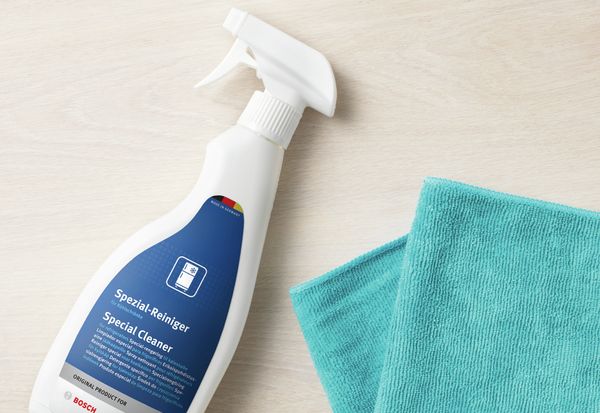
Fridge cleaning
We’ve already described how to keep your fridge clean above, so make sure you follow our advice. A weekly light clean is all it takes to keep your fridge free of harmful bacteria.
Do a thorough wipe with soap and water to remove any sticky residue that may get left behind on doors, shelves, drawers, seals and water dispensers. Wipe each of them dry with a microfiber cloth. We also recommend a quick lesson on the correct places to store food in your fridge, as this reduces the risk of foodborne bacteria while keeping food fresh and tasty for longer.
Cleaning your windows
We all want clean, streak-free windows that let as much light into our homes as possible, but it can be a little easier said than done if you go about it the wrong way. What’s the right way? We’re about to tell you.
A key factor when cleaning your windows is whether you’re using the right equipment. A bucket, a sponge, a squeegee with a rubber wiper lip, two microfibre cloths and a ladder are the essential tools you need to get started. Or if that sounds like a bit too much effort, you could use a cordless window vacuum instead. Whatever option you choose, good window cleaning can be done in three steps:
1. Soap up the windows in an ‘S’ shape.
2. Wipe down the windows in horizontal or vertical strokes.
3. Shine your windows after cleaning.
As a bonus tip, don’t forget to clean your windowsills and frames before you start on the glass. They’re a magnet for dirt and dust. Simply use a brush, dust cloth and rag soaked in warm soapy water. When it comes to cleaning fluid, here are a few options:
Ready-to-use window cleaning fluid from DIY stores
Hot water with a shot of dishwasher detergent or rinse aid
Hot water with vinegar or a dash of vinegar essence
Hot water with a dash of lemon
Hot water mixed with methylated spirit
If you’re using a cordless window vacuum, it will usually come with some window cleaning concentrate with instructions for diluting.
House cleaning tips
After reading through our super-detailed guide, you might already think you’ve learned all there is to know, but we’ve still got some pro tips on house cleaning up our sleeves.
Declutter the Japanese way
Before cleaning, we always recommend a declutter as step one. Japan’s Marie Kondo, also known as Konmari, has become world-famous for her decluttering tips. Three of our favourite suggestions include decluttering by category of items rather than the room, stacking vertically in cupboards, and folding everything that can be folded. Cleaning should always start with a declutter.
Clean in an orderly fashion
You’ve got to have a system. Go room by room and clean each room in a particular order, whether it’s top to bottom or left to right. Always wash in the same order and you’ll get faster and more efficient every time.

Get your washing machine to help
Your washing machine isn’t just for washing clothes. Make use of the multiple washing machine functions to clean curtains, sofa covers and much more – even your shower curtain on a gentle cycle.
Look after your laundry
Before you clean your house, remove laundry, bedding, towels and other fabrics from each room and put these in the washing machine. While you go from room to room, working through your house cleaning checklist, this helpful appliance can be doing some of the work for you.
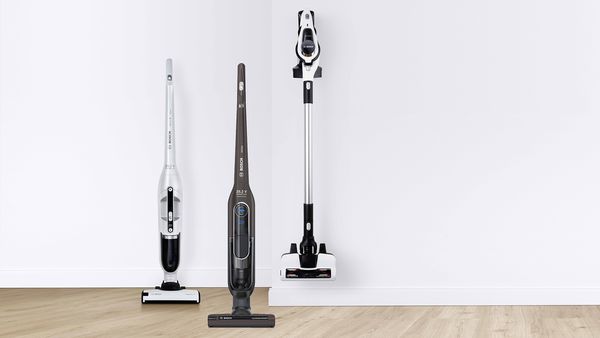
Clean your countertops
Try mixing a tablespoon of liquid detergent with a large quantity of warm water to create a cleaning solution for your countertops. For particularly troublesome stains, mix baking soda and water for an even more hard-hitting cleaning solution.
Vacuum like a pro
Use the right tool for the job! Vacuum cleaners come with a set of accessories designed to clean a range of surfaces and spaces. For example, the crevice tool helps you get to all of those hard-to-reach spots (such as dryer vents, around refrigerators, ductwork and cars). In contrast, the upholstery tool helps you to clean furniture, curtains and car interiors gently and thoroughly.
These tools were made to make your life easier, so use them to your advantage. It’s incredible how many people forget they’re there and use the same nozzle for everything. Also, always vacuum at the end of your cleaning routine. By vacuuming last, you’ll suck up any dirt and dust that has been shifted onto the floor from activities such as dusting and wiping down tables.
In terms of your actual vacuuming order, we recommend starting with lampshades, then furniture. Corners next, finishing with hard floors. Another pro tip is to vacuum floors in rows – up and down, working your way from one side of the room to the other. It’s efficient and effective.
Finish off your floors
Multi-function vacuum cleaners have features specifically for hardwood and laminate floors, so it’s worth looking out for those. Alternatively, an old-fashioned mop and bucket work well on lino and tile floors with stuck-on dirt. At the same time, less dirty surfaces can be wiped clean with a damp microfiber cloth.
If you have expensive hardwood flooring or laminate, check for any specific manufacturer’s instructions before cleaning for the first time. Water or cleaning fluids may not be suitable. We find it’s always handy to have an old-school brush for sweeping up on hard surfaces too.
Multitask with the dishwasher
While you’re busy cleaning the rest of the house, load up your dishwasher with dirty dishes, so it’s one less job to worry about. It’s a great way to help you multitask. Alongside this, it’s also more hygienic, saves water and is likely to be more effective when it comes to cleaning tough baked-on stains.
You could also consider investing in a high-quality dishwasher with an antibacterial cleaning function, which ensures maximum hygiene by killing 99.9% of germs. This helps keep your kitchenware much more sanitary, which is essential for young children or family members who have allergies.
Clean your taps with vinegar
Keep your taps gleaming and free from mineral deposits caused by hard water by wiping them down with white vinegar. It may sound strange, but it works.
Use newspapers on your windows
Get streak-free windows with his unique expert tip – simply use scrunched up newspaper to shine your windows after washing and drying. It removes streaks in a flash.
Wave goodbye to messy microwaves
If the inside of your microwave is looking like a Jackson Pollock painting, then it’s time for a deep clean. Get rid of stubborn stains and splashes by microwaving a coffee mug filled with hot water before you start cleaning. This will create moisture that will loosen the dirt and make cleaning much more manageable.
Look after your appliances
If you look after your appliances, they’ll look after you. It’s worth investing in the right home appliances like a quality vacuum cleaner, washing machine and dishwasher. These can share the load when it comes to house cleaning and will make your life considerably more comfortable.
Just remember to look after them to get the best performance time after time. For instance, with your dishwasher, run a maintenance wash on an empty load and add in a dishwasher cleaner to remove any grease and limescale build-ups. Repeat every three months to keep your dishwasher running at its best!
It’s equally important to give your washing machine drum a good clean too. Every 2-3 months run a wash program which operates at 90℃ with an empty load and some bleach. Some washing machines also come with a clean drum programme to effectively eliminate odour and germs.
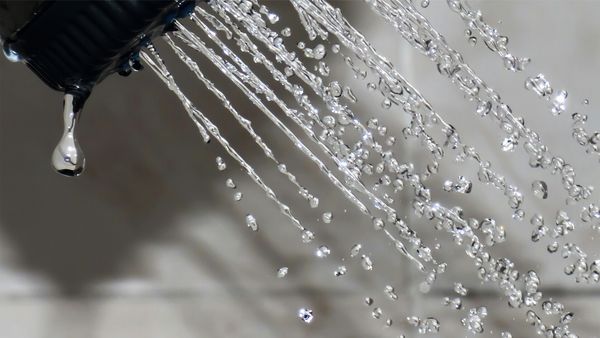
Don't get distracted when you're cleaning
One of the reasons that professional cleaners can tidy a house faster is that we have a tendency to get distracted by our belongings. In contrast, a cleaning service is just there to do a job. When cleaning your own home, take a similarly professional and objective approach. In other words, try not to get distracted by those old family photos and keep cleaning.
Clean proactively
Basically, don’t wait until a problem appears before you deal with it. By cleaning proactively, you can prevent time-consuming and stressful house cleaning problems before they rear their ugly heads. For example, after you’ve finished showering, spray the showerhead with shower cleaner and rinse. This only takes a few seconds but will prevent you ever having to scrub.
Keep your stainless steel spotless
You might be surprised to learn that just like leather, stainless steel has a ‘grain’, which experts recommend you should follow when wiping or polishing your appliances.
The grain runs either horizontally or vertically and has a ‘brushed’ appearance. Finding it and rubbing or cleaning in the same direction will give your appliances extra shine. What can you use to clean stainless steel? Here’s a simple guide.
For limescale, use diluted vinegar and a soft cloth to gently buff. For adhesives like sticky tape residue, use a little mild acetone solution (similar to nail polish remover) and wipe gently. For coffee or tea deposits, use a sprinkle of baking soda, allow it to absorb and then simply wipe away. Microfiber cloths are the best since they do not scratch the surface of the appliance and soak up as much water as possible.
And finally, for minor scratches try this hack – simply apply a thin layer of toothpaste to the small scratches and buff gently with a toothbrush. This gets off superficial and small surface scratches like a charm.
Battle black mould
Keep your bathroom well-ventilated to avoid dreaded black mould. And take a minute to wipe down your tiles and shower door after using the shower to remove excess moisture. Also, avoid leaving damp towels to dry in your bathroom. If mould and mildew do appear, use a dedicated spray, containing hydrogen peroxide, to remove it.
Fresh air, clean home
You may not have considered this as part of your house cleaning regime, but keeping the air in your home fresh is just as important as wiping down surfaces. We spend 90 per cent of our time indoors and worryingly the air in our homes can be five times dirtier than outside.
How can we make the air in your home fresher, cleaner, and crisper? The simplest way is to ventilate your house by opening windows and doors for at least ten minutes a day where possible. We also recommend investing in a vacuum cleaner with a HEPA filter. You could also consider a dehumidifier or air-conditioning unit. There are natural remedies too. House plants such as aloe vera, chrysanthemum and bamboo palm are naturally air-purifying. At the same time, beeswax candles help neutralise toxic compounds in the air as they burn.
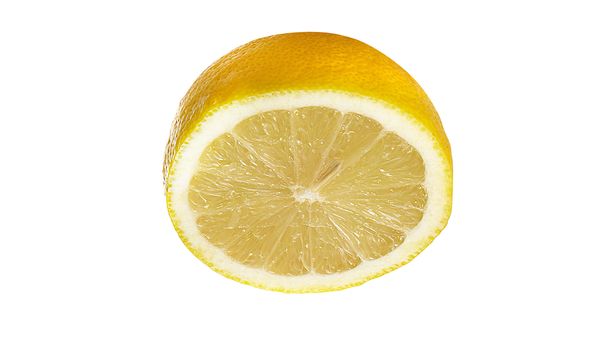
Cleaning with lemon
Rust stains can be notoriously hard to shift, but don’t worry – we’ve got a pro tip you’re going to love. Cut a lemon in half and squeeze it over the stain. Let the juice soak for ten minutes and then scrub with a stiff bristle brush. The acid from the lemon juice will dissolve the rust and it’s completely natural. After you’ve finished, give the area a wash down with cold water. Repeat as many times as necessary.
Stay on top with fast, thorough maintenance cleaning
How to keep your house clean? By staying on top with regular, scheduled cleaning. The more often you clean your home, the less often you’ll need to do a major deep clean. Cleaning experts recommend scheduling regular cleans to keep on top of your rooms, so things never get out of control.
Rather than being more work, this will reduce the amount of time, effort and energy you have to put into house cleaning, so make time for regular maintenance clean. You’ll save time in the long-run.
Clean house, happy home
You did it! The kitchen is gleaming, the bathroom is spotless, the beds are made and the living room is dust-free. Breathe in that clean, fresh air, pat yourself on the back and get ready to relax. Your house is clean!
Almost everything worth achieving in life requires a little hard work to make it happen. House cleaning is no different. Whether you love or loathe housework, we can all agree that cleaning your home is a necessary activity. And there is a real payoff for doing it well, especially if it’s not your favourite job in the world.
Suppose you use your time and energy efficiently and effectively. In that case, you can clean your home faster, better and with less difficulty than ever before. Little and often – with a thorough deep clean every now and then – can go a long way to keeping your home clean and your household healthy and happy. And when it comes to house cleaning, that’s where the real pleasure is to be found.

